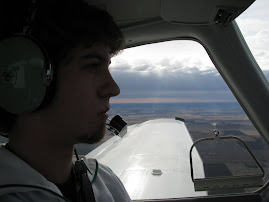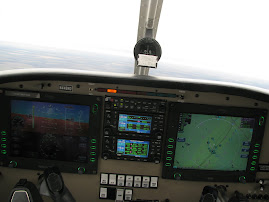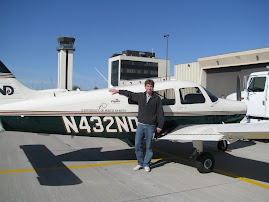After canceling the morning cross country flight to Bemidji, I made sure to catch a few more hours of sleep before I went up on my night flight.
Flying at night is the same as, yet completely different than flying during the day. Everything that's done during the day has to be done at night, but with more caution. You should always use caution while flying, but night flying is that much more dangerous. Then there's the additional procedures you should follow to keep your eyes in good shape throughout the flight.
When we pre-flight the aircraft, we don't exactly have the light of day to help us see, so we bring flashlights. These flashlights have to have two lenses; a white one is used to inspect the outside and the red is used at all times inside the aircaft. Because I didn't see any other alternatives I could buy, my flashlight was shaped like a normal flashlight. My instructor's flashlight was a headlamp that she just hung around her neck when using it inside the cockpit.
While readying the aircraft inside, I was struggling to handle both my kneeboard and documents, my map, my pen, my flashlight, and my hand used for pushing all the shiny buttons. My instructor saw me struggling and probably let it go for a bit so she could get a good laugh before she offered to switch lights. Seeing as I was the one that would be on the controls and needing both hands, I readily accepted. I hung the headlamp around my neck, as she did, so the red light didn't flood the entire cockpit, just around my kneeboard, map, and notes on my lap. Just in case you don't know why, the red light is used inside the cockpit to ease the strain on our eyes so we can still see outside the aircraft.
Once we were in the air it was a different feeling than flying during the day. I could see the lights of Grand Forks clearly. But I could also see all of the distant towns that usually blend into the horizon in the day. We proceeded to fly east of Grand Forks heading towards the Crookston, MN area. I saw a group of towers on my map ahead of us and when I looked up, sure enough there they were with there flashing red lights. We were well above them, don't worry, I'm just pointing out the fact that towers are terrible (invisible?) waypoints during the day, but at night they are the next best thing after a bright town.
My instructor told me to find the Crookston airport. I looked at where it should've been, but did not see it. I checked my map and made sure I was looking at the right spot in relation to the town of Crookston. My instructor reminded me of the fact that I can control the brightness of the airport lights. So I tuned the frequency in and gave the radio 7 clicks within 5 seconds and..."let there be light!" Cheesy reference, I know, but that's the kind of difference it made taking the airport lights up to there maximum brightness.
On the flight back to Grand Forks, the two reporting points we pass over, when inbound from the northwest, are made of water. They are the water treatment facilities for Grand Forks, so it's a good thing that smell doesn't penetrate into our aircraft. Because they are made of water, they have no lights on them, meaning there's a whole lot of nothing that is hard to see. The second reporting point, nicknamed Lagoons, is slightly easier to see because it's right on the corner of the airport and it has a lighted road passing through the middle of it.
Landing an airplane at night is supposed to be hard, but I didn't consider it so. I kept my eyes moving so I could, because of how human eyes are made, keep focus on everything I need to see at night. I divided my sight between checking the glide slope indicator the runway alignment, my speed indicator, and making sure the runway numbers didn't move within my windshield. I dropped my flaps at the correct intervals, kept my wind correction in, and gradually pulled that throttle back once I had the runway made.
I touched down so softly on the runway that I was questioning if we were all the way down. That was just a touch'n'go. On the second landing I touched down exactly on the centerline that my instructor told me to aim for, albeit a little harder, but I wasn't allowed to float down the runway to smooth it out. It was up to me if we would head in after 2 or 3 landings. When on final approach for the second landing I decided to make it a touch'n'go as well so I could get 3 night landings in. I was cleared for the option, meaning I could perform any landing I wanted, so it was acceptable to make that slightly late decision. Plus we had the plane and we had the time, so why not?
We went around for a third time before calling it a night. We taxied and parked the aircraft as the maintenance crews were pulling all the aircraft into the hangars for the night; we were among the last to fly for the night. Unlike another flight school, we actually have hangars that fit every single aircraft in our fleet. Very helpful for when winter comes, or say....a Christmas day tornado?
On the way back from the airport, I made a mental note to myself to go to Walmart and buy a red and white light headlamp to use. If it makes flying easier without making it dangerous, then there's nothing wrong with it.
Monday, November 3, 2008
Subscribe to:
Comments (Atom)




